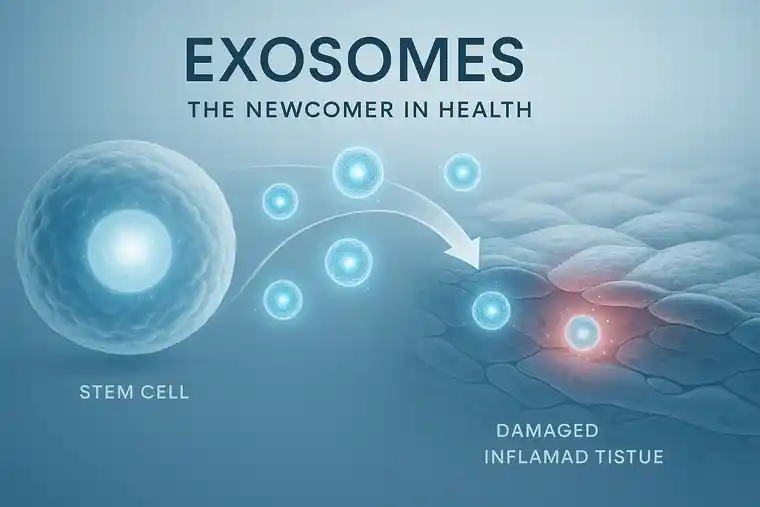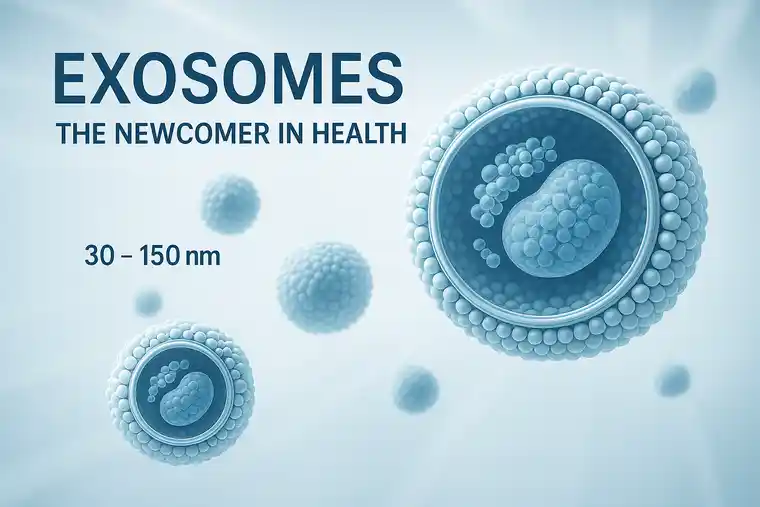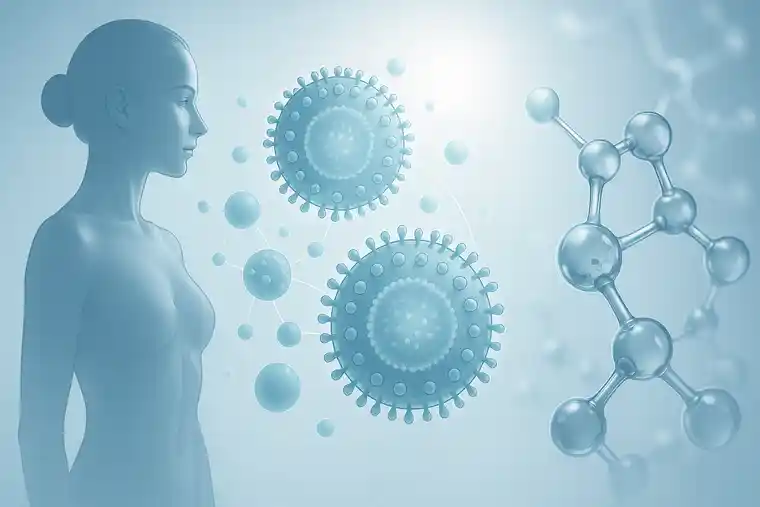Exosomes: The Future of Healing – Smaller, Smarter, Safer
Cell-Free Regeneration | The Intelligent Power of Exosomes

Exosomes and the New Era of Healing: Beyond Repair, Toward Intelligent Regeneration
Medicine stands at a fascinating threshold. The old model of replacing damaged parts is giving way to something far more subtle—and arguably more powerful. Rather than brute-forcing repairs, we are now beginning to speak the body’s own biological language, tapping into the innate regenerative capabilities written into our DNA.
For decades, stem cell therapies carried the hope of reversing aging, repairing damaged tissues, and even curing chronic disease. And they’ve delivered remarkable results. Yet, over time, clinicians and scientists noticed something intriguing. The most powerful regenerative effects often did not come directly from the stem cells themselves—but from the microscopic messengers they released.
These are exosomes—tiny vesicles smaller than viruses, carrying with them the molecular blueprints of healing.
From Stem Cells to Exosomes: The Elegant Shift in Regenerative Medicine
When stem cells first entered the clinical scene, they were hailed as a breakthrough, offering a new toolbox for healing where traditional medicine fell short. The idea of injecting young, vibrant cells into aging or damaged tissues was revolutionary.
However, as research progressed, a more elegant biological mechanism came to light. Exosomes, the naturally produced vesicles that stem cells secrete, were responsible for much of the regenerative effects scientists observed. They weren’t just passive byproducts. They were active, intelligent messengers, delivering highly specific instructions to surrounding cells on how to repair, regulate, and rebalance themselves.
This understanding has triggered a quiet revolution in regenerative medicine. Clinicians, researchers, and patients alike are now turning toward cell-free exosome therapies, embracing them as a safer, more precise, and more scalable approach to healing and longevity.
The Science of Exosomes: Nature’s Precision Messengers
Exosomes measure between 30 to 150 nanometers, invisible to the naked eye but loaded with a treasure trove of bioactive molecules:
- MicroRNAs and mRNAs
- Proteins
- Lipids
These tiny carriers, especially those harvested from mesenchymal stem cells (MSCs), are proving to be potent tools for:
- Modulating immune function
- Guiding tissue-specific progenitor cells into repair pathways
- Resetting chronic inflammation cycles
- Recalibrating mitochondrial and metabolic dysfunctions
Unlike stem cells, exosomes are cell-free and contain no nuclear material, meaning they carry none of the risks associated with cell-based therapies, such as:
- Tumor formation
- Unwanted differentiation
- Immune rejection

Exosomes in Action: From Disease Modulation to Peak Longevity
Unlocking the Brain’s Healing Potential
Emerging studies show that exosomes can cross the blood-brain barrier, making them invaluable tools in addressing:
- Alzheimer’s disease
- Parkinson’s disease
- Post-stroke recovery
- Traumatic brain injuries
Cardiovascular Precision Repair
In cardiology, exosomes are being explored as tools to repair the heart muscle after infarction, stimulate new blood vessel growth (angiogenesis), and even reverse fibrotic damage in heart failure patients.
Resetting Autoimmunity and Chronic Inflammation
Autoimmune diseases like lupus, rheumatoid arthritis, and multiple sclerosis are now being addressed by exosomes that recalibrate T-cell activity and downregulate pro-inflammatory cytokines.
Patient Perspective: Anna, 43, Lupus Patient Turned Biohacker
“After 15 years on harsh medications, I discovered exosome therapy. Within months, my energy returned, my flare-ups decreased, and even my skin and hair regained life. For me, exosomes weren’t an alternative—they were a reintroduction to my body’s forgotten intelligence.”
Tackling Long COVID and Systemic Inflammation
Exosomes are emerging as frontline tools in resolving post-viral syndromes, such as:
- Long COVID
- Chronic fatigue syndrome
- Fibromyalgia
Exosomes and Aging: Rewiring the Biology of Time
Aging isn’t simply about wear and tear—it’s the progressive miscommunication between cells and their environment, leading to chronic inflammation (inflammaging), mitochondrial dysfunction, and tissue degradation.
Exosomes derived from young, vibrant MSCs carry the signatures of youth, capable of:
- Boosting skin elasticity and dermal health
- Stimulating vascular regeneration
- Recalibrating metabolic pathways in aging organs
- Reducing senescence markers
Patient Insight: James, 55, Tech Founder and Longevity Investor
“I’ve spent years optimizing sleep, hormones, and diet, but nothing recalibrated my biology like exosomes. My inflammation markers dropped, my energy feels ten years younger, and my biometric data surprised even my doctors. Exosomes are not anti-aging—they are cellular alignment.”

Elite Bio-Optimization: Exosomes in Performance and Aesthetic Medicine
Exosomes have rapidly become the treatment of choice in elite clinics for aesthetic rejuvenation, sexual optimization, and performance medicine. Applications include:
- Skin and scar rejuvenation beyond PRP
- Hair regrowth stimulation in androgenic alopecia
- Erectile rejuvenation and female sexual health enhancement
- Joint, tendon, and muscle recovery acceleration
High-Purity Exosomes: Why Quality Matters More Than Ever
⚠ The exosome market is booming—but not all exosomes are created equal.
Visionary clinics now partner exclusively with labs adhering to:
- Ethically sourced MSC donors (umbilical, placental, or dental pulp)
- GMP-certified lab environments
- Advanced purification methods (nanofiltration, ultracentrifugation)
- Proteomic and RNA fingerprinting validation
- AI-driven batch consistency and quality control
The Billion-Dollar Exosome Revolution: Global Trends and Market Dynamics
The global exosome therapy market is on a trajectory to surpass $2 billion by 2030, driven by:
- Over 400 active clinical trials globally
- Rising demand for cell-free precision medicine
- Major investments by biotech giants and visionary longevity venture funds
- An elite class of patients seeking more than symptom management—seeking systemic recalibration and performance longevity
Skeptics and Realities: The Road to Regulation and Transparency
While promising, exosome therapies currently navigate a regulatory gray zone. Patients must be wary of:
- Clinics overpromising or exaggerating results
- Low-quality products lacking proper validation
- Lack of patient follow-up or transparency protocols
Visionary clinics and regulatory pioneers are collaborating to build the frameworks of next-gen regenerative medicine, ensuring:
- Safety and efficacy standards
- Robust patient consent models
- Transparent outcomes tracking
The Future of Personalized, Predictive Medicine with Exosomes
In the coming years, exosomes will integrate with genomic data, AI modeling, and biomarker tracking to enable:
- Monthly exosome signal analyses for biological age monitoring
- Tailored exosome formulations for individual health goals
- AI-driven longevity optimization plans as part of routine care
Conclusion: Why Visionary Leaders Are Betting on Exosomes
For those who lead industries and demand control over their health, exosomes offer more than a therapy—they offer a biological strategy for the next era of performance, longevity, and resilience.
This is not about forcing the body to heal. It’s about unlocking the code within—activating the body’s inherent potential to regenerate, recalibrate, and thrive.
Because those who master their cellular conversations today will shape the way they age, perform, and lead tomorrow.
Ready to Experience the Future of Regenerative Medicine?
Exosome therapy is redefining what healing can look like—targeted, intelligent, and cell-free. Whether you’re managing a chronic condition, optimizing performance, or investing in your longevity, our experts at MedClinics are here to guide you.
Request your private consultation and unlock cellular-level healing with our expert team.
FAQ
Is Exosome Therapy really that different from Stem Cell Therapy?
Yes. Exosomes are the communication molecules secreted by stem cells—the bio- intelligent signals that do most of the repair work. While stem cells are like factories, exosomes are the blueprints, messengers, and repair instructions—without the risks of unwanted cell behavior, immune rejection, or ethical concerns.
How quickly can I expect to feel or see results after Exosome Therapy?
This depends on the condition and your biology.
• For skin and aesthetic treatments, patients often report improvements within 2–4 weeks.
• For chronic conditions like autoimmune or neurological issues, systemic recalibration may take 3–6 months, with progressive improvements.
• Athletes using exosomes for recovery and performance often feel differences in inflammation, energy, and recovery time within weeks.
Are there any side effects or risks with Exosome Therapy?
When sourced and prepared under GMP-grade conditions by qualified labs, exosomes have minimal side effects, such as mild local irritation post-injection. However, risks arise when using unvalidated products or from clinics with poor sourcing transparency. This is why patients should always demand full lab validation certificates and clinical-grade sourcing proof.
How do I know if the exosomes used are high-quality and safe?
Ask your clinic:
• Is the source from young MSC donors (umbilical, placental)?
• Do you provide batch validation data (size analysis, proteomics, RNA profile)?
• Is your supplier GMP-certified and do you provide safety testing reports (endotoxin, sterility)?
Elite clinics will have this ready.
If they hesitate, walk away.
Can Exosome Therapy help me if I’m healthy and just want to optimize longevity and performance?
Absolutely.
Exosome protocols are now used preventively by high-performance individuals, longevity investors, and athletes, aiming to:
• Recalibrate inflammation before it triggers disease
• Optimize mitochondrial and metabolic functions
• Support skin, vascular, and organ youthfulness
In short: Optimize, not just fix.
Does it work for patients who have tried everything else—stem cells, PRP, surgeries?
Many patients turn to exosomes after years of failed conventional therapies.
Exosomes often provide results where other interventions plateaued because they address cellular miscommunication and immune dysregulation at the signaling level – not just at the tissue level.
Real Patient Quote: “After 3 stem cell treatments with minimal gains, exosomes were my breakthrough. My chronic joint inflammation finally calmed down. It was as if my body started ‘hearing’ the repair signals again.”
Are exosomes legal in the US, Europe, and other countries?
Exosomes are currently in a regulatory gray zone, often classified as:
• Biologics (subject to regulation)
• Tissue-derived products (under specific rules)
This varies by country. High-end clinics in countries like Germany, Switzerland, Korea, and Dubai currently offer exosome therapies under progressive, safety -focused models.
Can exosomes be combined with other treatments like stem cells or peptides?
Yes.
In fact, combination therapies are showing promising synergies. Exosomes can enhance the efficacy of stem cells, peptides, and other regenerative protocols by preparing the cellular environment for better signaling and repair.
I’m an executive/athlete with little downtime. Can exosomes fit my lifestyle?
Absolutely.
Exosome therapies are minimally invasive, require no general anesthesia, and have no downtime.
Many elite patients fly in for same-day protocols and return to their routines within hours.
Protocols can even be tailored for travel, boardroom, or competition schedules.
What should I expect to pay for a high-end exosome treatment program?
Premium clinics offer:
• Single infusions from $2,500 up to $20,000, depending on dose, application, and lab standards.
• Comprehensive multi-week/multi-system optimization programs ranging from $10,000 to $100,000+, often including personalized biomarker monitoring, gene profiling, and AI-driven optimization plans.
Remember:
This is biological precision engineering, not cosmetic wellness. Price reflects quality, safety, and the caliber of lab and clinic you choose.
Author: Dr. Deniz Kök
Blogs and Patient Story’s
Types of Treatments
Powered by ISSCA, REGEN, and MedClinics - connecting a global network of pioneers to shape the future of regenerative medicine.
Heal from Within | The Power of Stem Cells
Request Form
Get your free consultation
- Need guidance and reassurance?
- Talk to a real person from MedClinics!
- Let's find the perfect doctor together.